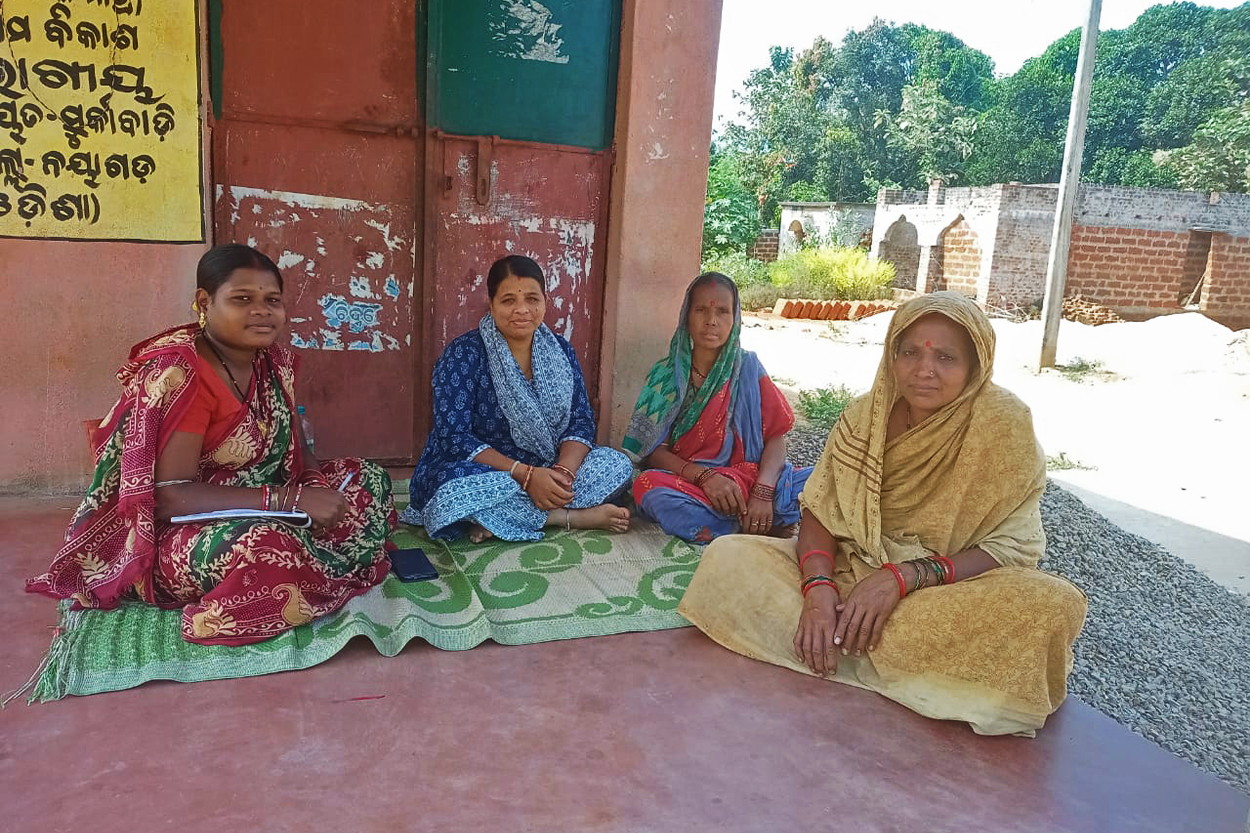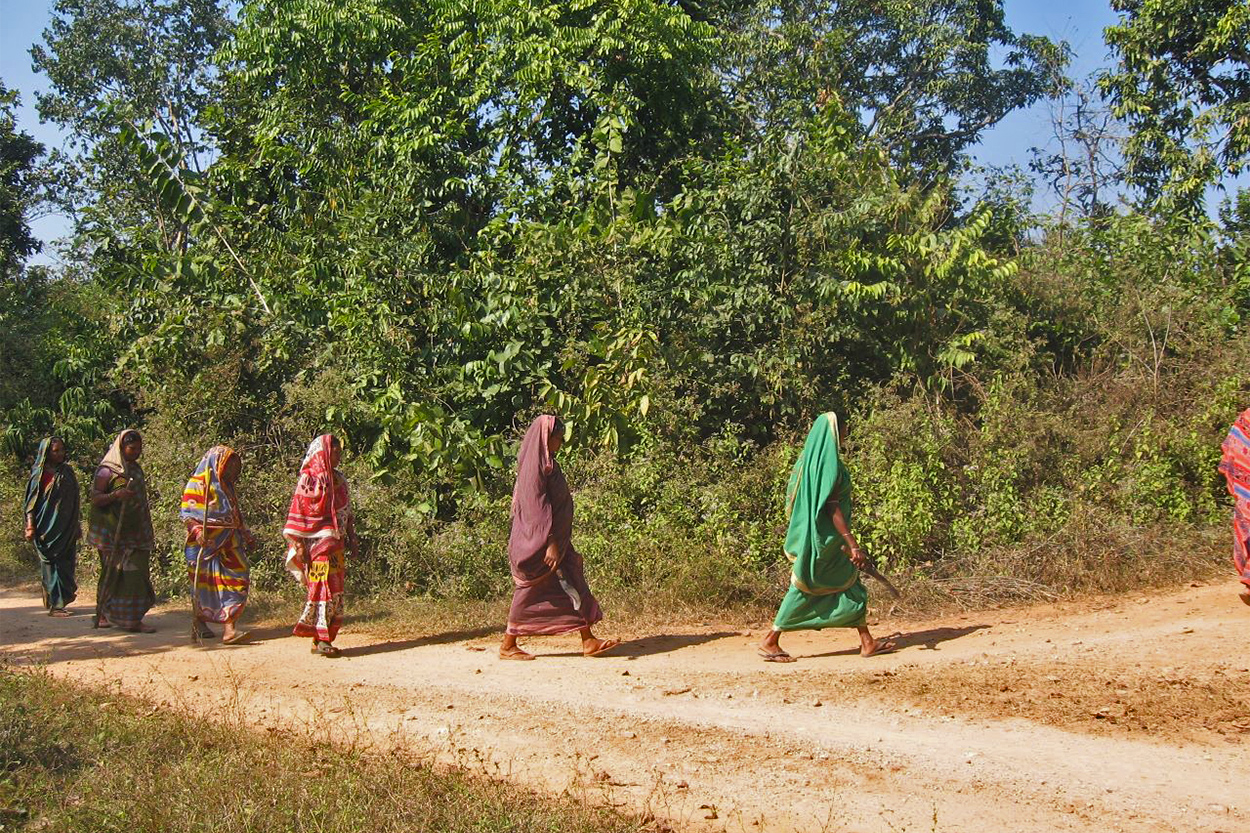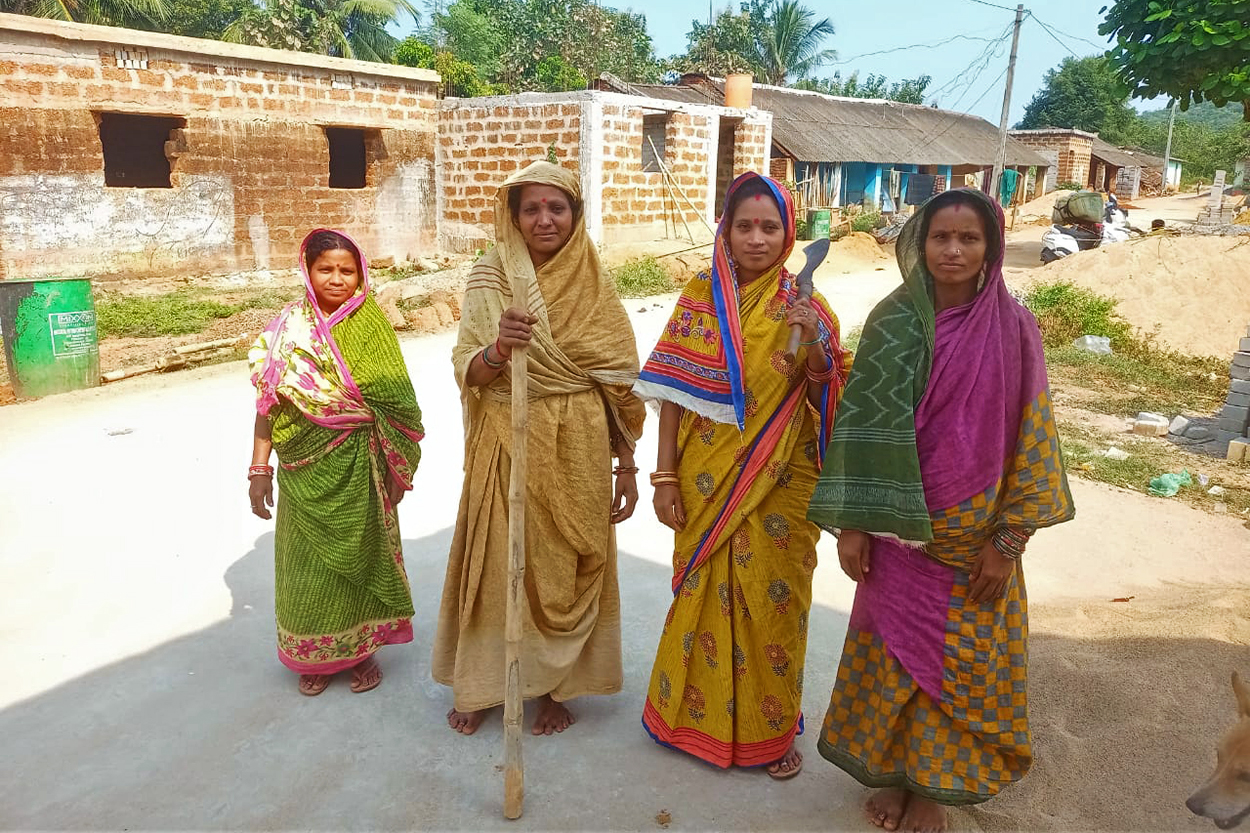- In 2021, the village of Kodalpalli in Odisha’s Nayagarh district became one of the few places in India where the country’s landmark Forest Rights Act of 2006 (FRA) was translated into formal rights for traditionally forest-dependent communities.
- This July, the east Indian state of Odisha launched a scheme to expand FRA coverage to 30,000 villages that are home to tribal groups and other traditionally forest-dwelling communities.
- It took Kodalpalli villagers more than 10 years to get their claim validated; by then, a women-led forest stewardship scheme called thengapalli had been in place for about four decades.
- Experts say the legal right has helped strengthen existing community-based institutions and practices like thengapalli while opening up new livelihood opportunities for residents.
Pramila Pradhan, 51, embraced thengapalli, a form of forest stewardship, because of her mother-in-law, who took her along on forest patrols. Thenga means stick, and palli means turn or rotation. For decades, stick-wielding women have taken turns every day to patrol and safeguard the woodlands in Kodalpalli village in India’s Odisha state.
But it was only in 2021 that the Indian government recognized their rights over communal forest resources. With this recognition, Kodalpalli became one of the few places in India where the country’s landmark Forest Rights Act of 2006 (FRA) has been translated into formal rights for traditionally forest-dependent communities.
The FRA seeks to remedy the exclusion faced by these groups, which deepened under British colonial rule and persisted in independent India. It was a belated acknowledgment of the centrality of forested areas to people’s lives and the latter’s importance to the persistence and well-being of India’s forests.
“More than 50% of forest land in India can be recognized and protected as community forest resource with the effective implementation of FRA,” said Tushar Dash, an independent researcher who works on forest rights. That’s at least 40 million hectares (100 million acres). Groups that receive collective rights are required to incorporate principles of sustainable management once their claims are approved, but proving sustainable management is not the basis for granting the rights.
Seventeen years since the law’s passage, more than 90% of villages across India that are eligible for community forest rights under the FRA still lack them, according to civil society organizations. But this July, the state of Odisha launched a scheme to expand FRA coverage over the next two years to comply with the legislation. If it succeeds, it will become the first state in the country to do so. Nearly 750,000 families in around 30,000 Odisha villages stand to benefit.

Wresting forest rights from the state, with its help
Until now, only communities that organized themselves and built capacity with the support of local organizations won their rights under the FRA. The people of Kodalpalli, for example, used the FRA very effectively, Dash said. Expanding the FRA on a scale envisioned by the Odisha government can’t happen without the wholehearted endorsement of official agencies and grassroots organizations, he said.
What forest rights campaigners find encouraging is that, for the first time, a state government set aside dedicated funds for FRA implementation. Odisha is also appointing community mobilizers, one for every 10 villages, paid and trained by the government. FRA cells are opening at the district level, and civil society organizations are being roped in. The NGOs are getting financial assistance to support communities in securing their rights. Vasundhara, a nonprofit focused on securing tenure rights, is helping 12,000 villages in 15 districts with this work.
At the same time, the act doesn’t grant communities wholesale rights to forested land. Rather, it enshrines claims that communities can show they held customarily — be it individual rights to cultivate inside forested areas for sustenance, a community’s right to live on and off forested land, or a village’s right to manage forests within its boundaries and access forest produce.
Sitting on India’s eastern shore, Odisha is home to 62 tribal communities. These groups, along with other forest-dwelling communities, protect about a third of Odisha’s forest estate, said Y Giri Rao, executive director of Vasundhara. Like Kodalpalli, these are areas where people’s daily needs, livelihood, culture and identity are bound to their forests.
The need to reestablish community forest management was born out of the marginalization, persecution and criminalization forest peoples faced during British rule. They stood in the way of intensive extraction of forest resources by colonial authorities, in particular timber. Post-independence, from 1947, tribal groups and other forest-dependent villages continued to be excluded from its management by India’s forest department. The central government agency perpetuated an imperialist approach, treating forests as revenue-generating assets rather than the life-sustaining systems communities see them as.

Under the department’s watch, forests across the country, including in Odisha, withered away. Between 1880 and 1960, India lost 2 million hectares (5 million acres) of forest every decade. Deforestation started to slow down only in the 1980s, after the Forest Conservation Act, but it wasn’t consistent.
Tribal and forest-dependent communities saw the green cover they relied on disappear and degrade while their customary rights to the forest, to live in and tend for their ancestral environs, continued to be ignored.
It took nearly 60 years since independence for the Indian state to redress this historical injustice and promote a rights-based approach to forest conservation and management through the FRA. However, to date, its potential remains largely unrealized, Dash said. One of the biggest hurdles is the forest department’s resistance to relinquishing control, not implementing provisions under the act, or, worse, perversion of rules to deny legitimate claims. “Rejection of claims illegally or wrongfully has been one of the major problems in getting recognition of rights,” Dash said.
In the case of Kodalpalli, it took villagers more than 10 years to get their claim validated. Two years ago, they were granted a Community Forest Resource Rights (CFRR) title under the FRA, along with a neighboring village, Sinduria, for 283 hectares (698 acres) of forests. By then, the women-led management system called thengapalli had been in place for about four decades.
“In these villages, they had de facto systems like their own committees for forest protection, which are now legally recognized. They have more power, and there is proper documentation of rules, regulations, and practices like thengapalli,” Dash said.

‘No one can protect our forests like we can’
Most villages that are eligible for FRA titles “already have some customary arrangements to safeguard forests,” Giri said. “In many tribal areas we see a form of cultural protection.” Several tribes in Odisha, like the Dongria Kondh, believe their deities reside in and protect the verdant hills of their homelands, and this acts as a deterrent to cutting trees or clearing these ancient woodlands. The last vestiges of the state’s pristine forests are found in tribal areas, Giri said.
Among other forest-dwelling communities, these rules and regulations are more formalized, whether that means hiring forest guards or taking on the mantle themselves.
Under the thengapalli system, any illegal loggers the women come across are brought to the village and punished per communal law. For example, they may be asked for an apology or pay a fine. If the watchwomen encounter armed loggers, they return to the village for backup. These are mostly outsiders, Pradhan, treasurer of the village forest protection committee, told Mongabay, and sometimes they’re people from neighboring villages. Kodalpalli residents inform a village committee before going into wooded areas and for what purpose, whether collecting fuelwood or gathering food.
Women came to lead this form of forest stewardship because they found men ran into many difficulties in doing so. Men were either willing to overlook wrongdoing to preserve relationships, or prone to be victims of violent confrontations, Pradhan said. What makes women more effective is a slew of laws on violence against women that act as strong deterrents against harassment. Illegal loggers are less likely to get into physical altercations with the thengapalli sentries than with men.
Gendered roles and expectations for men and women also shape their distinct relationships with the natural world. For one thing, women spend more time in the forest than men. They’re much more knowledgeable about the different species and their utility. In their worldview, the forest isn’t a collection of timber-laden trees, but a space that holds life’s essentials: food, fuel and medicine.

Women map the forest differently, too. They know which village is using which tracks for what purpose. Around Kodalpalli, there are some villages that don’t have their own forest land. In an example of accommodation, the women of Kodalpalli allow limited access for neighboring villagers who aren’t involved in forest protection. In case of infractions, these are brought to the notice of village elders, and an entire village can be barred from the woodland, creating social pressure to adhere.
To share the responsibility of protecting the forests, returning patrol teams place their staffs in front of the homesteads of other women, who will set out the next day. The handover is symbolic of a change of guard. But out in the forest, the bamboo canes are also practical tools to scare away wild animals: tigers, bears and snakes.
Until two years ago, it wasn’t just the wildlife the women were wary of running into. Before getting their CFRR title, Pradhan said, their entry into the forest was sometimes opposed by forest department personnel, who considered them trespassers.
Under forest protection regimes where the control is concentrated with the forest department, there’s little flexibility. Handing over the reins to communities eschews the one-size-fits-all approach, Giri said. “Community-managed areas are more accommodative and based on the needs of the people,” he said. This is especially true with women in charge.
The community titles are formally granted to the gram sabha or village assembly, a fundamental unit of local governance in India. However, for forest management, the assembly created a forest protection committee. In Kodalpalli, this is made up entirely of women. Married women, who shoulder household responsibilities and are familiar with the lay of the forestland, usually take part in thengapalli.

Responsibilities, possibilities and difficulties
Yet the rights are also a responsibility, adding to existing duties traditionally considered within women’s domain. For their thengapalli rounds, the women wake up at around 3 or 4 a.m. to finish their household chores before heading out and returning in time to prepare lunch.
In some other villages in the region, residents pool funds to hire forest guards. Pradhan, however, said they favored taking on the task themselves. “This is our habit. We take our time,” she said. “Why should we give hired guards money?” She said the money was better saved and spent on their children’s education. “Four women are better than one guard,” she said. “We can keep a lookout in all directions.
“No one can protect our forests like we can,” Pradhan added.
The communities aren’t just custodians of the forests. Centuries of living lives entwined with their environment, seeing it in all its seasons and hues, informs more expansive conservation. In some areas, villagers can take migratory bird species under their wing. This year, Govindpur village in Odisha declared itself a “Birds Village” and committed to protecting avian visitors to the Hirakud reservoir.
For Kodalpalli residents the legal claim not only ensures they can rightfully enter the forest, but it also opens up livelihood prospects. There are 20.6 hectares (50.9 acres) of cashew plantations within the Kodalpalli forest. Before 2021, this harvest was controlled by the government-owned Odisha State Cashew Development Corporation Limited, and some plantations by the forest department. These agencies auctioned it and collected revenues.
Now, the cashew crop is in the villagers’ hands, and this year, villagers earned around 500,000 rupees ($6,000) in total by selling it to local traders. “They can also plan their livelihoods,” Dash said, such as looking for ways to generate income from other forest produce like tendu leaves and bamboo. “They are coming out with new ideas of how the community forest areas or nontimber forest produce can be collectivized,” he said.
Pradhan told Mongabay that the state corporation and forest department’s loss of the cashew revenues was one reason they faced opposition in their quest for rights to forest resources.

At the same time, some of the challenges are emerging from within the community. Sustaining the forest protection system will be an uphill task, with younger generations increasingly seeking opportunities elsewhere, moving away to urban centers. So is passing on traditional knowledge and reproducing intimate ties to the natural environment.
In 2017, to address this issue, women in the village established a jungle kutir, a school for young children, where village women hold fort once a month to teach them about the forest by narrating their own stories and experiences of forest management.
Though the tide of migration is sweeping away the youth, Pradhan said it’s mostly men leaving for towns and cities for seasonal work. Their families and, importantly, the women of the village usually stay behind. In some ways, the thenga sticks aren’t just circulated among today’s custodians. The women also expect to pass the baton over generations: Pradhan said she hopes to recruit her future daughter-in-law into thengapalli one day.
Banner image: Women in Kodalpalli village in Odisha’s Nayagarh district take the lead in forest management and patrols. Image courtesy of Bhagyalaxmi Biswal/Vasundhara.
